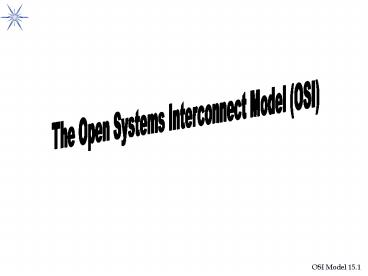The Open Systems Interconnect Model OSI - PowerPoint PPT Presentation
1 / 28
Title:
The Open Systems Interconnect Model OSI
Description:
Explain the reasoning for using a model like the OSI for ... Routing and switching at IP layer (network) Puts header and lets network deal with packet ... – PowerPoint PPT presentation
Number of Views:60
Avg rating:3.0/5.0
Title: The Open Systems Interconnect Model OSI
1
The Open Systems Interconnect Model (OSI)
2
Open Systems Interconnect Model Objectives
- Objectives for Chapter 15
- Describe the OSI Model
- Converse openly about the seven-layer
architecture - Compare the differences between the OSI and other
models - TCP/IP, IBM SNA, DEC DNA
- Explain the reasoning for using a model like the
OSI for transparent communications - Describe the importance of reliable
communications for moving data
3
Open Systems Interconnect Model Convergence
Networks
- Three techniques
- Data on data networks
- Modems for the voice network
- Digital-to-analog and analog-to-digital
- Battle over compatibility, not technology the
managers perspective - Proprietary and closed architecture SNA
- DEC formed their own (but similar to IBM)
strategy - Users wanted to connect to both IBM and DEC
4
Open Systems Interconnect Model Architecture
Planes
- Hierarchy of IBM mainframe connection arrangements
5
Open Systems Interconnect Model SNA and DNA
- Architectures
- SNA
DNA
6
Open Systems Interconnect Model Transparency
- Protocol converter
7
Open Systems Interconnect Model Point and Hide
- Who is at fault?
8
Open Systems Interconnect Model Protocol
Converters
- Multi-key strokes as part of emulation
9
Open Systems Interconnect Model Reference Model
10
Open Systems Interconnect Model Comparisons
- Comparing OSI, DECNet, SNA
11
Open Systems Interconnect Model An Example of
the Model in Action
12
Open Systems Interconnect Model In Action
13
Open Systems Interconnect Model In Action
Simultaneous Tx and Rx
14
Open Systems Interconnect Model In Action
More complicated
Bottom Three Layers of the Model
15
Open Systems Interconnect Model In Action
Layers can be met through this network.
16
Other Network Architectures SNA
- SNA some characteristics
- Application software uses a standard interface
for communications - All data links use same set of rules, called link
control procedures - Applications can exchange data with each other
- All applications can be intertwined to allow
multiprocessing capabilities - Regardless of location, different devices can
access any application on any host - Function of SNA augment and supplement the local
area network
17
Other Architectures SNA Components
- Level of control
- Each device under control of next level up
- Terminals function under the cluster controller
(CCU) - Controller functions under the front end
processor (FEP) - FEP functions under the Host
- Network addressable unit (NAU) emphasizes the
device to a network, program, or other device - Systems service control part (SSCP)
- Physical unit (PU)
- Logical unit (LU)
18
SNA SSCP
- SSCP
19
SNA PU
- Physical Unit
20
SNA LU
- Logical Unit types (sessions)
- LU0 special applications, IBM or user define
parameters - LU1 between host and remote batch terminal
- LU2 between host and 3270 display terminal
- LU3 between host and 3270 display printer
- LU4 between host application and word
processor, or between two terminals - LU5 under study
- LU6 between two or more different applications,
i.e., - an APPC, session between application program in
a host and an application program in an
intelligent workstation or terminal
21
SNA Architecture
22
Open Systems Interconnect Model SNA Evolution
- First SNA networks simple hierarchy (shown
previous slide) - Later changes in VLSI
- Dumb terminals became intelligent workstations
- PCs and midrange computers introduced
- Changed complexion of network, contained their
own processing and storage - Natural evolution to allow for distributed
processing - SNA evolved with the market
- Adopted more of a peer-to-peer processing
capability - Adopted advanced peer-to-peer networking strategy
23
Digital Network Architecture (DNA)
- DEC (Now owned by Compaq)
- Model and architecture of DECNet
- System of communications hardware and software
enabling DECs OS and components to function in
network with other DEC systems and other non-DEC
systems - Two separate stacks
- 1) Supports proprietary DEC environment
- 2) Supports OSI model (not 100)
- DECNet functions
- User functions
- Network functions
- Communications functions
24
Open Systems Interconnect Model DNA Comparisons
25
Internet Protocols (TCP/IP)
- Widely accepted in data communications
- Included in all forms of UNIX
- Middleware for connectivity
- Two most important features
- Ability work with just about any environment
(uses application interfaces to emulate most
services on other architectures) - Ability to packetize data and send it out
- TCP/IP stack
26
Internet Protocols IP
- Internet Protocol (IP) makes packets (datagrams)
- Segments large files
- Routing and switching at IP layer (network)
- Puts header and lets network deal with packet
- Datagrams not sequentially numbered
- Makes best effort, but no assurance data will
arrive and error free - Nodes along the way deal with errors, sequencing,
TTL
27
Internet Protocols TCP
- Transmission Control Protocol overcomes
limitations of IP - Byte count header on info delivered to the IP
- Becomes part of datagram, responsible for putting
data in right order, ensuring accuracy - ACK or NAK sent back to origin
- TCP holds all later bytes (5,6,7) until datagram
4 resent (buffers data at receiving end) - Makes data reception and accuracy the
responsibility of end user (node), not network - Trend using fiber optics, quality of network is
high - Movement last ten years toward TCP/IP and the
Internet
28
Open Systems Interconnect Model Notes Page
- Notes, Chapter Fifteen































